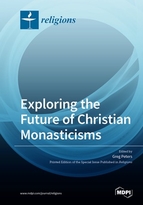Exploring the Future of Christian Monasticisms
A special issue of Religions (ISSN 2077-1444).
Deadline for manuscript submissions: closed (1 June 2019) | Viewed by 35425
Special Issue Editor
Special Issue Information
Dear Colleagues,
The institution of Christian monasticism (or, perhaps more accurately, Christian monasticisms) is, in many ways, well studied. In general, the broad outlines of its rich and variegated history are understood, its sociological underpinnings have been explored, and those Christian churches that have monastic communities can provide theological rationale(s) for their existence. What is often overlooked, and perhaps only rarely discussed by “monastic insiders” (particularly in light of the declining number of monks), is the future of monasticism, at least from a constructive theological standpoint. That is, Christian monastic history is understood, and the historical theological foundations are common knowledge, but what will the future of Christian monasticism look like? Will it continue along the already tried and true ways of historic monasticism? Or will it undergo a radical reformulation to connect integrally to its predecessor while looking like an institution adapted to the twenty-first century?
Perhaps a more “traditional” way of speaking about this would be to ask the following question: Will the historic vows of poverty, chastity, and obedience (or, for Benedictines, stability, obedience, and fidelity to the monastic way of life) continue to form the foundation of Christian monasticism? Will monks and nuns continue to take life-long vows? Will they continue to live as celibates? Though there has been much experimentation in monastic living over the past fifteen years (e.g., the so-called “New Monastic” or “secular monastic” communities), many of these experiments have been criticized for being not so much monasticism per se as experiments in communal living. Thus, the following question still needs to be answered: What will the future of monasticism qua monasticism look like in the future?
To that end, this Special Edition of Religions seeks contributions that will look at the history, sociology, and theology of monasticism in order to formulate constructive suggestions for the future of the institution. Contributions will explore the nature of Christian monasticism in all its facets with the purpose of ressourcement: recovering for the future what can be learned from the monastic past.
Prof. Dr. Greg Peters
Guest Editor
Manuscript Submission Information
Manuscripts should be submitted online at www.mdpi.com by registering and logging in to this website. Once you are registered, click here to go to the submission form. Manuscripts can be submitted until the deadline. All submissions that pass pre-check are peer-reviewed. Accepted papers will be published continuously in the journal (as soon as accepted) and will be listed together on the special issue website. Research articles, review articles as well as short communications are invited. For planned papers, a title and short abstract (about 100 words) can be sent to the Editorial Office for announcement on this website.
Submitted manuscripts should not have been published previously, nor be under consideration for publication elsewhere (except conference proceedings papers). All manuscripts are thoroughly refereed through a double-blind peer-review process. A guide for authors and other relevant information for submission of manuscripts is available on the Instructions for Authors page. Religions is an international peer-reviewed open access monthly journal published by MDPI.
Please visit the Instructions for Authors page before submitting a manuscript. The Article Processing Charge (APC) for publication in this open access journal is 1800 CHF (Swiss Francs). Submitted papers should be well formatted and use good English. Authors may use MDPI's English editing service prior to publication or during author revisions.
Keywords
- monasticism
- religious life
- history of monasticism
- sociology of monasticism
- theology of monasticism






